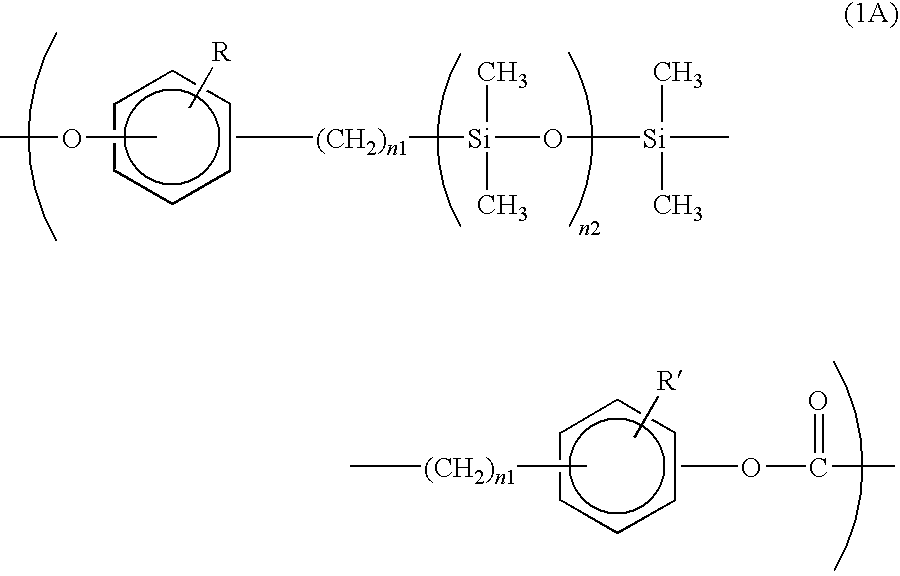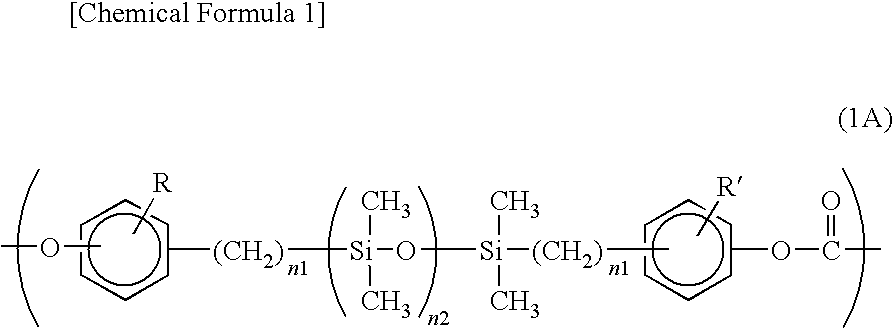Polycarbonate polymer, coating liquid, and electrophotographic photosensitive body
a technology of polycarbonate polymer and coating liquid, which is applied in the direction of electrographic process, instruments, corona discharge, etc., can solve the problems of bisphenol a described above, bisphenol z, and insufficient polycarbonate resin to meet the above demand, and achieve excellent electrophotography property and scratch resistance, excellent stability, and excellent durability. and electrical characteristics
- Summary
- Abstract
- Description
- Claims
- Application Information
AI Technical Summary
Benefits of technology
Problems solved by technology
Method used
Image
Examples
first embodiment
[0048]A polycarbonate polymer (hereinafter, occasionally referred to as “copolymerized PC”) according to a first exemplary embodiment, a coating liquid using the copolymerized PC, and an electrophotographic photoreceptor formed of wet type molding with use of the coating liquid will be described in detail below.
[Structure of Copolymerized PC]
[0049]The copolymerized PC according to this exemplary embodiment includes a monomer unit represented by a formula (1A) below and a monomer unit represented by a formula (2) below.
[0050]
[0051]In the formula (1A), R and R′ each independently represent a hydrogen atom, a halogen atom, an alkyl group having 1 to 12 carbon atoms or a substituted or unsubstituted aryl group having 6 to 12 carbon atoms; n1 is an integer in a range of 2 to 4; and n2 is an integer in a range of 25 to 700.
[0052]
In the formula (2), Ar represents a divalent aromatic group.
[0053]According to this exemplary embodiment, a haze of a solution that is obtained by dissolving the ...
second embodiment
[0147]Next, a polycarbonate polymer (hereinafter, occasionally referred to as “copolymerized PC”) of the second exemplary embodiment according to the invention will be described in detail.
[0148]In describing this exemplary embodiment, what has been described in the above first exemplary embodiment will be omitted or simplified.
[Structure of Copolymerized PC]
[0149]The copolymerized PC according to this exemplary embodiment includes a monomer unit represented by a formula (1B) below and a monomer unit represented by a formula (2) below.
[0150]
[0151]In the formula (1B), R represents an alkyl group having 1 to 3 carbon atoms; n1 is an integer in a range of 2 to 4; and n2 is an integer in a range of 55 to 700.
[0152]
In the formula (2), Ar represents a divalent aromatic group.
[0153]A haze of a solution that is obtained by dissolving the copolymerized PC according to this exemplary embodiment in THF (tetrahydrofuran) at a concentration of 10 mass % is 5% or less (according to JIS K7105, opti...
third embodiment
[0178]Next, a polycarbonate resin (hereinafter, occasionally referred to as just “PC resin”) as a polycarbonate polymer of the third exemplary embodiment according to the invention will be described in detail.
[0179]In describing this exemplary embodiment, what has been described in the above first and second exemplary embodiments will be omitted or simplified.
[Structure of PC Resin]
[0180]A PC resin according to this exemplary embodiment contains a monomer unit represented by a formula (2) below and has a structure in which at least one end of the PC resin is terminated by a terminal group represented by a formula (1C) below.
[0181]
In the formula (2), Ar represents a divalent aromatic group.
[0182]
[0183]In the formula (1C), Z is an aliphatic hydrocarbon group having 2 to 6 carbon atoms, preferably an alkylene group, particularly methylene chain; R represents an aliphatic hydrocarbon group having 1 to 6 carbon atoms; R2 to R5 each independently represent a hydrogen atom, an aliphatic hy...
PUM
| Property | Measurement | Unit |
|---|---|---|
| optical path length | aaaaa | aaaaa |
| mass % | aaaaa | aaaaa |
| length | aaaaa | aaaaa |
Abstract
Description
Claims
Application Information
 Login to View More
Login to View More - R&D
- Intellectual Property
- Life Sciences
- Materials
- Tech Scout
- Unparalleled Data Quality
- Higher Quality Content
- 60% Fewer Hallucinations
Browse by: Latest US Patents, China's latest patents, Technical Efficacy Thesaurus, Application Domain, Technology Topic, Popular Technical Reports.
© 2025 PatSnap. All rights reserved.Legal|Privacy policy|Modern Slavery Act Transparency Statement|Sitemap|About US| Contact US: help@patsnap.com



